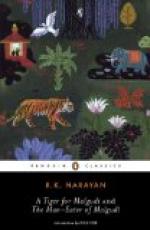|
This section contains 3,362 words (approx. 12 pages at 300 words per page) |

|
SOURCE: "Tradition and Transformation in R. K. Narayan's A Tiger For Malgudi," in International Fiction Review, Vol. 14, No. 1, Winter, 1987, pp. 8-13.
In the following essay, Atkinson discusses Narayan's depiction of Hinduism and its relationship to everyday life in A Tiger for Malgudi.
R. K. Narayan is often labeled "a small town ironist," who, with gentle humor, lays bare the weaknesses, foibles, and incongruities of ordinary people. As well, Narayan addresses fundamental questions about human existence, creating in Malgudi a fictional microcosm of India that embraces the organic wholeness of the Hindu tradition. Here Narayan is especially sensitive to how humankind falls short in its religious ambitions, as his characters repeatedly settle for less than the ideal and are frustrated by the fundamental limitations of being human. In Narayan's most recent novel, A Tiger for Malgudi (1983), these limitations emphasize the unsettling disjunction between the philosophical underpinnings of Hinduism and...
|
This section contains 3,362 words (approx. 12 pages at 300 words per page) |

|


